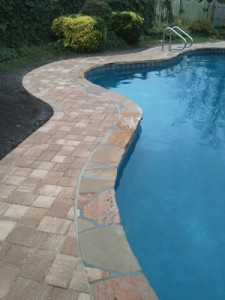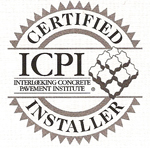 When building a swimming pool, choosing a deck is an important part of the design process, since a lot of people spend as much time around the pool as in the pool. A deck should provide room for entertaining, hanging out and sunbathing.
When building a swimming pool, choosing a deck is an important part of the design process, since a lot of people spend as much time around the pool as in the pool. A deck should provide room for entertaining, hanging out and sunbathing.
One of the most important considerations for any pool deck is the type of material to use.
Broom Finished Concrete is the standard type of decking for a swimming pool. It is normal light gray concrete with a broom finish on it for slip resistance. This is the least expensive and most practical option. It stains easily and like any other concrete flat work can develop cracks.
One of the biggest trends in outdoor design today is a decorative concrete pool deck, a colored, textured and inviting area surrounding the pool providing a safe, slip-resistant deck for entertaining and sunbathing.
Textured Concrete is a decorative concrete application. There are many types of textured concrete products. These are polymeric based cement materials sprayed on top of existing concrete offering a decorative surface that is stain and slip resistant. With the use of stencils you can achieve many different designs including brick, flagstone and tile. It can be applied over new and old concrete. Best for renovation of existing concrete.
Stamped Concrete is a decorative concrete application that is designed to resemble brick, slate, flagstone, stone, tile and even wood. This is achieved when patterns are pressed into the concrete before it sets. The colors and patterns are plentiful, but the material may fades over time and like any other concrete flat work can develop cracks. Also, this surface can be slippery and may cause some concern for pool areas.
Exposed Aggregate Concrete is another decorative concrete application. When the concrete is poured and begins to set, a retarder is applied to the entire surface of the concrete. This allows all but the cement paste on top to continue hardening. The cement paste is then washed off which exposes the rock or gravel in the concrete mix. The pebble-like finish of an exposed aggregate pool deck can create dramatic-looking results that enhance and complement the textures surrounding your pool. This finish is a little rough on bare feet and like any other concrete flat work can develop cracks.
Pavers are interlocking formed pieces of concrete that are available in a wide variety of patterns, colors and styles. They are also referred to in the industry as paver stones or concrete pavers. The use of pavers is growing rapidly in both commercial and residential projects as more and more people discover both their beauty and their practical advantages. Pavers more than any other material, will allow you to design a truly unique and aesthetic focal point in your backyard. They give your pool deck a high end decorative look. The strength and longevity of individual units set this type of pool deck apart from any other.
Coping Options
There are a few different options available when choosing coping styles. This is usually determined by the type of pool deck being used.
Aluminum Coping is the most common style used on vinyl liner pools. This style coping creates a smooth and uniform perimeter around your pool. It is usually white but can be painted any color and works very well with concrete pool decks.
Cantilever Coping is another option for concrete pool decks. This style coping is achieved by using removable forms which allow the concrete to be poured over the swimming pools edge. It cannot be used on all concrete surfaces and is rougher that aluminum coping.
Paver Coping is most commonly used on pools that also have a paver pool deck. You can install paver coping to accent concrete pool decks but it is usually cost prohibitive to do so. There are many different styles and colors to choose from when installing this type of coping.


